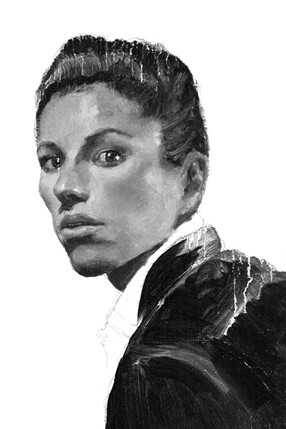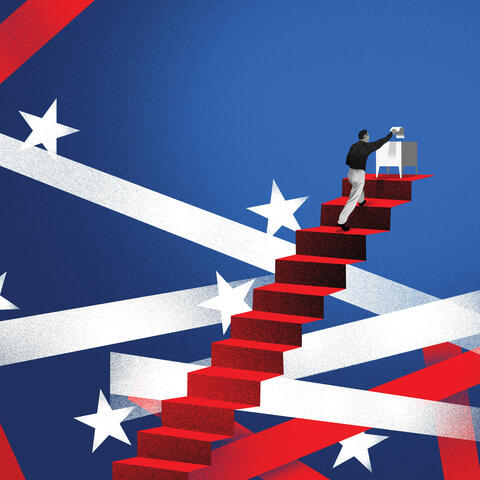Veritalk: Puttin' On the Ritz
The third and final episode in our series about Plumage.

Veritalk is a podcast produced at Harvard’s Graduate School of Arts and Sciences. In each three-episode miniseries of Veritalk, you’ll hear how PhD students from different fields are trying to answer really big questions about the world. Subscribe on Apple Podcasts.
American Studies PhD student Chloe Chapin began her career as a costumer in New York. No matter how hard she tried, she could never find detailed information about menswear from different eras. So she started asking questions: Why is menswear so uniform, while women's fashion embraces all sorts of decorative, embellished outfits. In other words, why is "plumage" so dependent on gender? And what happens when we start to bend those gender rules?
Full Transcript
I mean, why?
ANNA FISHER-PINKERT: From the Harvard Graduate School of Arts and Sciences, you’re listening to Veritalk. Your window into the minds of PhDs at Harvard University.
I was curious. . . I’ve always wondered. . . why?
This is our final episode about Plumage: From birds to bling – the very deep reasons behind the most superficial things on earth.
Episode 3: Puttin' on the Ritz

AFP: So far, we’ve talked with PhD student Dakota McCoy about how birds evolved to prefer exciting, bright colors.
DAKOTA MCCOY: If you are a bird that has evolved to eat orange fruit, you're going to probably evolve to like how orange fruit look and be attracted to orange fruit.
AFP: And we talked with applied physics PhD students Victoria Hwang and Annie Stephenson about how scientists can make some of those remarkable colors in a lab setting.
AFP: It really just looks like some sort of unicorn, like in a bottle.
ANNIE STEPHENSON: Unicorn blood.
AFP: Unicorn blood, right yeah.
AS: It's everyone's favorite.
AFP: The birds that inspired Victoria, Annie, and Dakota all have something in common: the males are the ones who have bright colors and fancy feathers, and the females are duller have better camouflage. Some bird species do have colorful females and dull males. But the key thing is that plumage plays a role in advertising your sex, and in finding a mate. And that led me to wonder. . . if humans do the very same thing?
CHLOE CHAPIN: I’m Chloe Chapin. I’m a PhD student in the American Studies program here at Harvard.
AFP: I asked Chloe to come into the studio to talk about how humans use plumage to express themselves.
CC: I was trained as a costume designer and I worked as a costume designer in New York for ten years doing a wide variety of types of projects: Shakespeare, downtown experimental dance theater, big Broadway musicals, opera -- kind of a whole range. And so as a costume designer, I thought a lot about clothing as a medium for how people express who they are.
AFP: We're talking about plumage on this show and how seemingly superficial decoration reveals something about how the world works. So what does fashion tell us about our culture and about society.
CC: I mean, you could sort of argue that fashion is the original plumage. You know, can you separate out fashion from human? There’s a belief within fashion studies that fashion started in the Burgundian courts in the 15th century, but there's also an argument that the very first examples of decorations of humans that we have from the Venus figures that include decorative hair braiding and string skirts, are also a kind of fashion, even if it doesn't function as quickly as current ideas of fashion -- which really means more like trends than, as you are saying, plumage or decoration or some sort of signaling about what kind of person you are, your gender, or your status -- that sort of thing.
AFP: Can you talk a little bit more about what things we can signal with what we wear.
CC: Yeah. So I think historically, the primary functions of clothing, beyond protecting you from the elements, have been about advertising your gender and your status. Within gender there are other things that you need to advertise - mostly your marriage availability if you're female. So that's historical. But it also still could be argued that those things are happening today. One of the really interesting things that's happening in fashion right now is around the conversation of gender, and the way that we're sort of breaking down ideas around how binary it is "supposed" to be, and finding a little bit more nuance. And fashion is absolutely reacting to that with ideas of not just androgynous fashion, or unisex fashion, but the sort of more gender nonconforming area. And a lot of designers from, you know, website only stores to high couture designers are looking at that sort of thing. So the the kinds of plumage that we often talk about in fashion - so much of it has to do with broadcasting sexuality that I think conversation and gender are really important to talk about that because we're seeing a real shift in and how we advertise. How and what we want to advertise.
AFP: In contemporary society, a woman might want to advertise her masculinity. Or a nonbinary person might want to advertise their androgyny. The potential combinations of gender and gender presentation are endless. But if you have to go out in the world and buy an outfit – those options are. . . pretty limited.
CC: But I think that one of the things that's so interesting about fashion is how both how quickly it can adapt to new cultural ideas but also how slowly it moves, too. So even though we're talking about different ideas in terms of gender non-conforming identities, in a way fashion is still very binary in terms of its ideas about things like plumage. There are all these new tailoring companies that are marketing suits to trans men or lesbian customers. But even though they may be tailoring to a different body they're still really buying into this binary idea of suits or for men. And ladies don't wear suits.
Anna: So how did we all come to agree that a suit is “masculine,” but a high heel or a dress is “feminine?” Where did these rules come from in the first place? That’s one of the questions that Chloe is trying to answer.
CC: When I first made the transition from being a designer into academia, I was trying to figure out, like, what was the what was the story that I was interested in telling. And as a costume designer, it was so hard to find resources about menswear. You know, any period you were designing- you could find 75 books on flapper dresses or 18th century French court dress or maternity outfits. But there were like three books about menswear. And they would sort of summarize a 40-year period and two or three paragraphs and say: "Fashion changed so little in this period, it was the details that were really important" - but then they wouldn't ever tell you what those details were. So as a designer, when you're trying to replicate that era, it was very challenging trying to figure out what was the difference between a suit in 1910 and 1930.
I sort of naturally gravitated towards menswear when I made this shift just because it was something that I had wanted to know more about. And then within the world of menswear, I became interested in the suit as kind of a uniform. And within the world of suits, formal wear is sort of the most uniform of suits. So it kind of takes this idea of uniformity to almost a logical conclusion. It's the most uniform of civilian dress.
AFP: If I imagine an 18th century gentleman, maybe he is in the colonies or he is in England . . . I’m imagining like color and brocade and high heels . . . what happens to give men a uniform whereas women never get that uniform.
CC: That's the best question. That's basically why I'm writing on this topic for my dissertation. The psychologist John Karl Flugel, in 1930, coined this phrase “the great masculine renunciation.” And that's what he says is this shift that happens between the end of the 18th and the beginning of the 19th century. It's one of the fastest, most irreversible shifts in the history of fashion. Aside from maybe the industrial revolution -- which is not coincidentally happening at about the same time.
AFP: We should say that from here on out, we’re gonna focus on fashion in Western Europe and America. Back to Chloe.
CC: It used to be that fashion was divided into sort of rich and poor, and the way that you can tell the difference is by level of impracticality. So if you're wearing a toga, or a hoop skirt, or a fancy hat with a big streamer on the end of it, or heels, or a train. . . Anything like that demonstrates the fact that you are not the one picking potatoes, or doing the laundry, or carrying heavy stuff around. You can hire other people to do that stuff for you. So in the 18th century, even though there was a difference between male and female dress, it still would have been more obviously divided by the haves and the have-nots, because men would have still been dressing in a similar style of ostentatiousness with, as you said, fancy fabrics like velvets and embroidered silks and lacey cuffs and things like that.
AFP: Imagine, for example, the men and women at the court of Louis XVI at Versailles, in contrast to the urchins on the streets of Paris. Of course, that contrast was very obvious to French people at the time, who started an entire Revolution about it. I’m not just being flippant here. Fashion was so important to the French Revolution that it even made its way into the nickname for the working-class people who opposed the aristocracy: the sans culottes.
CC: Literally meaning “without breeches” - not without pants, but without those satin knee breeches of the aristocracy, or the ancien régime, as they would have been called. So these sans culottes were there were the revolutionaries.
AFP: After the revolution, the French had a problem: The old ways to project your importance through fashion now signified corruption and anti-republicanism. What, then, should a man of the New Republic wear?
CCL: And so they were literally employing the famous painters of the day like David to design a uniform for the New Republic, many of which were a very silly, sort of based on togas because they were looking at the classical world for inspiration.
AFP: That one didn’t quite pan out. Instead, the French took a cue from their more “rustic” English cousins, and started to dress in tailored woolens rather than silks.
CC: Starting around the 1790s, and through the first couple of decades of the 19th century, this shift occurred where fashion shifted from expensive, decorated fabrics to a more somber perfectly fitted -- this is when the rise of tailoring is happening. So, the switch from silks to woolens was really important because wool is a different kind of fabric and you can mold it through steam heat to fit the body differently. And they started adding padding and things like that, that were more suited for that particular type of material.
AFP: The other influence on fashion in this era was military dress, which was designed to be functional, and, of course, uniform.
CC: So all of people providing the uniforms for Napoleon's army were leaving and going to England. They were the ones who sort of established all the important tailoring shops in Savile Row.
AFP: A fashionable man in the 18th century might have worn lace, silk, heels or other “impractical” pieces. These guys had serious plumage. But a fashionable man after the “great masculine renunciation” would wear dark-colored, mostly unadorned suits. The new definition of masculinity in the 19th century is anti-plumage. Men’s clothing is all about blending in, not standing out.
CC: And so this idea catches on and becomes associated with the New Republic, the democracy in America. Suddenly this shift, this binary, goes from associating impracticality with "rich" to associating impracticality with "feminine." Because all of a sudden the kinds of fabrics that are being used in menswear, all of these woolens, are much more practical. And that feeds the new urban life that the industrial revolution and the new rise of cities is promoting.
AFP: The elite men of this era aren’t sitting in court with the king – they’re out in the city, they are running new factories, they’re engaged in trade and business and politics. So having a “uniform” set of clothing that’s relatively easy to move in, and relatively easy to clean, is something that becomes pretty desirable.
CC: So there's a much more obvious benefit to that kind of practical democratic form of dressing for men. But in a way women's clothing takes the opposite tack where they become much more ostentatious like the rise of the hoop skirt and bustles and things like that.
AFP: In other words, women’s fashion becomes all about plumage - dramatic hourglass silhouettes aided by corsets, layers of lace and silk, feathered hats, jeweled brooches – you name it. In contrast, throughout the 19th century, menswear starts to look more and more the same.
CC: I call it urban camouflage. You just want to wear what everyone else is wearing, whether you're talking about like bankers on Wall Street, or construction workers, or athletes. The idea is to fit in as much as possible.
AFP: It’s funny – because in nature, there are so many examples of the males of the species competing to stand out from the pack. If you think back to episode 1, Dakota McCoy suggested that birds of paradise are kind of engaged in an arms race - in which the colorful males develop increasingly beautiful plumage to keep up with the females’ increasingly sophisticated ability to see color. In the 19th and 20th century, for human males at least, it seems like the arms race goes in the opposite direction. Men enter an arms race to look as much alike as they possibly can - because having a practical uniform advertises masculinity. And it’s an arms race that continues to the present day.
CC: One of the things that started to get me interested in talking about suits is, you know, many of my male family and friends live in California and they're all kind of “dudes.” So many of them are like, "I got rid of my suits the day I retired!" or, "I haven't worn a tie since my wedding!" or, "I haven't been in a department store in 25 years!" And they're really proud of this -- like this is an important part of who they are.
AFP: Even the act of getting dressed in the morning is different for someone dressing in masculine clothes versus someone dressing in feminine clothes. Menswear changes very little from year to year, but it takes tremendous amounts of time and effort to keep up with trends in womenswear.
CC: There's all this research that has come out recently about decision burnout and I think it's interesting to associate that with uniforms because there's such a wide range of fashion available to women that isn't really available to men, at least not right now. And it just occurs to me that if you are spending so much time in the morning thinking, "Do I want a tailored look or a drapey look? Which designer do I want to wear today? Do I want to wear flats or heels? What kind of jewelry should I pick out how should I set my hair today?” You're not thinking about running a Fortune 500 company. And I think that that again is so such an ingrained part of ideas about gender is that women have this sort of gendered obligation to be decorative.
AFP: Not everyone is satisfied with this strict gender binary – and that includes people who wish menswear were a little less focused on blending in, and a little more open to different kinds of plumage.
CC: A lot of the responses that I've gotten from working on suits come from men saying how much they hate suits they hate this rigid conformity that they have to follow fall into when there isn't the same sort of … availability in the current culture of menswear to be able to wear bright colors or or floral patterns. And certainly there are always exceptions to these rules. But men are just as interested in being able to express and decorate themselves as women are. And now that there is more of a conversation around a wider spectrum of gender identity, I think the fashion industry is picking up on that, and looking at the sort of plumage or decoration in less of a specifically gendered sensibility.
AFP: But, as Chloe points out, the fashion industry is slow to change. Even when modern designers call a clothing line “androgynous” or “unisex,” the clothing itself tends to be more on the masculine end of the spectrum.
CC: Androgyny was really popular in the 90s, and unisex was a big buzzword in fashion in the 2000s. But a lot of that was really just menswear being repackaged for women. It wasn't much about men wearing skirts - with the exception of utilikilts or something like that. In fact, I think if you look outside of American fashion and you look at the some of the European brand menswear designers, they are much more likely -- I don't want to say bend the rules, because that implies that the rules are more important than exceptions to them -- but they're much more expressive. There's more of an impulse to embrace color and floral patterns and flashy socks and shiny accessories and things like that. So I think that America takes this real binary approach to dressing to a degree that other countries don't, really.
AFP: Chloe is thinking a lot about what it means to try to break down those deeply entrenched ideas about gender in fashion.
CC: Like, is there a perfectly non-binary outfit? There is a wide range of identities, and so expressing those can happen across the spectrum. There are some people who choose the sort of most middle of the spectrum that's neither womenswear nor menswear. But there are other people who like to combine those sort of extremes of "masculine" and "feminine," like having a full beard and wearing a dress. And there are certain people that like to present more masculine on one day and more feminine another day. And for them that's really an important part of their identity, the ability to be fluid like that. But it's hard to find one garment that expresses that kind of idea. So in a way, I feel like the exciting thing about the conversation is about unpacking our rigidness around definitions of fashion and clothing objects.
AFP: We don’t know yet that there is going to be a gender equivalent of the sans culottes, the French revolutionaries who made new fashion a key component of their fight for equality. But we do know that fashion is always evolving, sometimes in strange ways, sometimes in beautiful ways. And just like plumage in birds, fashion can tell us a lot about our species. How we differentiate ourselves, how we try to make ourselves fit in with the group. What at first appears to be frivolous can actually be really enlightening - whether you’re looking at an array of beautiful peacock feathers, a beaded gown, or a nanoscale crystalline lattice. As humans, we will come back to nature again and again to inspire our innovations in science, technology, and style.
This is our last episode about Plumage, but Veritalk will be back soon! Over the next few months, we’re going to talk with more amazing Harvard PhD students and alumni, and we’re going to puzzle out how all of their different ways of understanding the world intersect. Stay tuned, subscribe to Veritalk on Apple Podcasts, Stitcher, or Soundcloud – and if you feel like it, leave us a review! Five stars would be the ultimate in podcast plumage.
Thank you for listening. Veritalk is produced by me, Anna Fisher-Pinkert at the Harvard University Graduate School of Arts and Sciences. Our executive producer is Ann Hall. Our sound designer is Ian Coss. Our engineer for this series was Meagan Sobel. Our logo is by Emily Wilson. Special thanks to Dakota McCoy, Victoria Hwang, Annie Stephenson, Chloe Chapin, Jonathan Schmitt, Sam Hawkins, Anna Cowenhoven, Catherine Seraphin, and the Podcast Garage.
Get the Latest Updates
Join Our Newsletter
Subscribe to Colloquy Podcast
Simplecast




